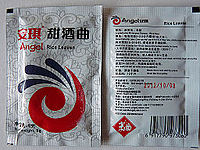
Photo from wikipedia
The use of non-Saccharomyces yeasts in sequential fermentations with S. cerevisiae has been proposed to improve the organoleptic characteristics involved in the quality of wine. The present study set out… Click to show full abstract
The use of non-Saccharomyces yeasts in sequential fermentations with S. cerevisiae has been proposed to improve the organoleptic characteristics involved in the quality of wine. The present study set out to select a non-Saccharomyces inoculum from the D.O.Ca. Rioja for use in winemaking. Strains included in the study belonged to Torulaspora delbrueckii, Lachancea thermotolerans, Metschnikowia pulcherrima, Zygosaccharomyces bailii, Williopsis pratensis, Debaryomyces hansenii, Pichia kluyveri, Sporidiobolus salmonicolor, Candida spp., Cryptococcus spp. and two mixed inocula of Lachancea thermotolerans-Torulaspora delbrueckii in a 30/70 ratio. In the first stage of the process, SO2 resistance and presence of enzymatic activities related to wine aroma and wine color and fining (esterase, esterase-lipase, lipase, leucine arylamidase, valine arylamidase, cystine arylamidase, β-glucosidase, pectinase, cellulose, xylanase and glucanase) were studied. In the later stages, selection criteria such as fermentative behavior, aroma compound production or influence on phenolic compounds were studied in laboratory scale vinifications. Taking into account the results obtained in the different stages of the process, a mixed inoculum of Lachancea thermotolerans-Torulaspora delbrueckii in a 30/70 ratio was finally selected. This inoculum stood out for its high implantation capacity, the production of compounds of interest such as glycerol and lactic acid and the consequent modulation of wine acidity. Given these characteristics, the selected inoculum is suitable for the production of quality wines.
Journal Title: Fermentation
Year Published: 2021
Link to full text (if available)
Share on Social Media: Sign Up to like & get
recommendations!